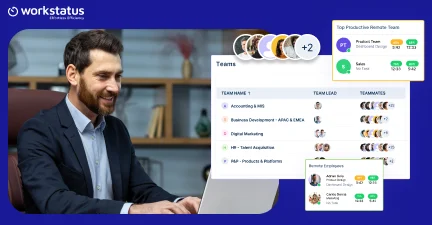Table of Contents
Introduction
We’re all trying to get more done in less time. But in the race to be productive, efficiency often gets overlooked.
What exactly is the difference between productivity and efficiency, and why does it matter?
Productivity is about getting a high quantity of output. Efficiency is about achieving results with minimal wasted effort or expense.
Did You Know?
58% of workers can’t distinguish between being productive and efficient.
However, the two are far from synonymous. Understanding the nuances can help optimize your work.
Meanwhile, ineffective multitasking drains up to 40% of productivity. Individuals and teams can enhance output and well-being by focusing on streamlining systems versus simply doing more.
You’ll learn actionable strategies to improve both as we delineate productivity and efficiency.
With some targeted tweaks, you can work smarter, avoid burnout, and boost your bottom line.
Let’s explore the differences between productivity and efficiency.
What is Productivity?
Productivity measures the amount of output a worker produces in a given time. Generally, we measure it in terms of either money (gross domestic product or GDP) or work units ( widgets per hour). Let’s see how to calculate productivity using the formula-
Productivity Formula= Total Output / Total Input
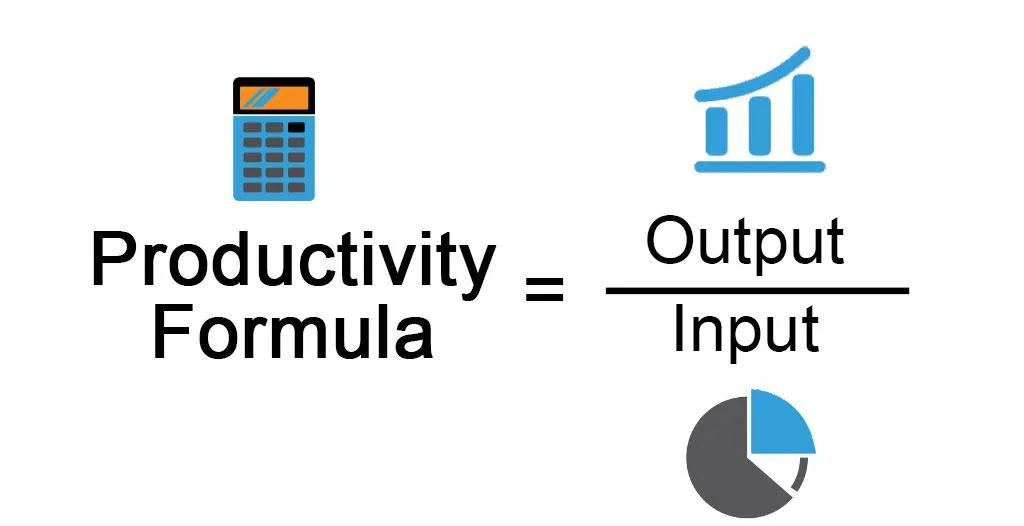
Productivity can be increased through various means, such as technology improvements that make workers more efficient, changes in work organization that help workers be more productive, or training and development that allows workers to improve their skills. Increasing productivity is essential for businesses to remain competitive and grow.
What is Efficiency?
We often describe efficiency as using resources in the most effective way possible. In other words, it is a measure of how well we can convert something into the desired output with the least amount of waste. This can apply to many areas, from machines to businesses to entire economies.
In general, efficiency divides the desired output by the required input and multiplies the result by 100%. Precisely, it can measure the productivity of a process or system. Higher efficiency percentage indicates more productive processes or systems. Let’s see the efficiency formula here-
% Efficiency= (Output/Input)x100
Why is efficiency important in the workplace: For example, we would consider a company that produces many products with few defects more efficient than one with a high rate of defects. And, we would consider an economy that can produce many goods and services while using few resources to be more efficient than one that is resource-intensive. We often see increasing efficiency as a key goal in many areas, as it can lead to increased productivity and decreased costs.
These two concepts might look similar at first, but there is a subtle difference when you compare them.
Productivity vs. Efficiency: Are productivity and efficiency the same thing
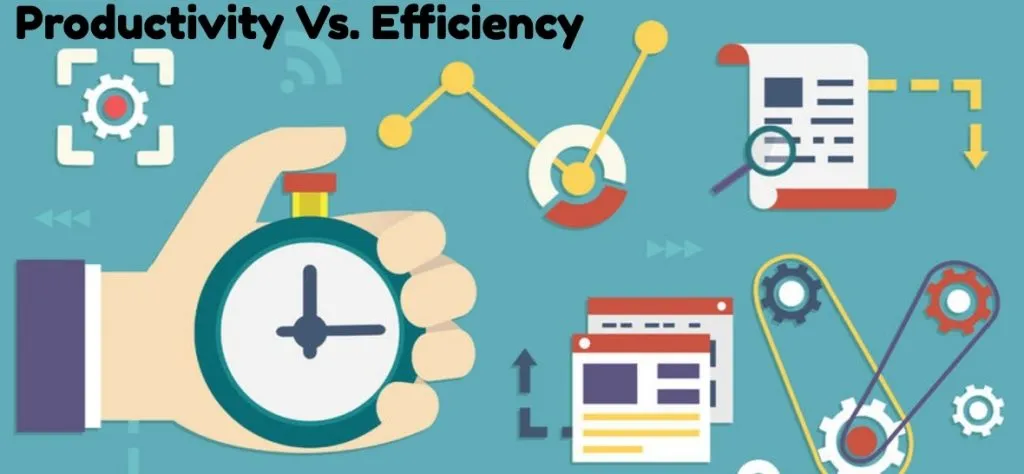
In most business circles, the words “productivity” and “efficiency” are often used interchangeably. While we may accept this in informal conversation, it is not technically correct.
Efficiency is the degree to which a person’s activities result in positive outcomes. The efficiency of an individual’s actions refers to how much effort and resources we put into work. In contrast, productivity is concerned with the quantity of work accomplished over a certain period.
Check this interesting comparison table on efficient vs productive parameters:
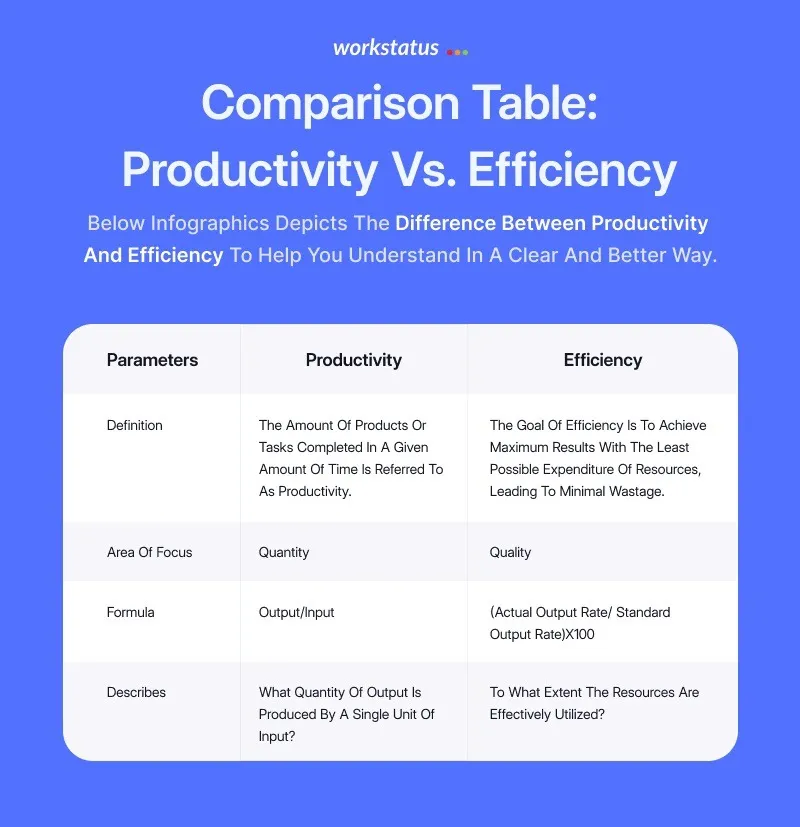
Let’s say a car manufacturing company can produce 50 cars per day. A productivity-oriented company will try to increase the number of cars they can produce daily.
So, your employees have worked hard, and now they can produce 60 cars per day. They have just become 20% more productive.
Whether they have 8 hours or one hour, the productivity-oriented company can still work at the same rate. They have to produce as much as possible, even if their total count drops due to cuts.
Read More: Maximize Productivity of Employees
Efficiency is all about trying to complete the same amount of work with fewer resources.
Let’s say your company, which can now produce 60 cars per day, gets its budget slashed. Now, the company is trying to finish the same amount of work (60 cars produced per day) with fewer resources to process them. This time, you should focus on efficiency.
Top 8 Ways To Be More Productive and Efficient at Work
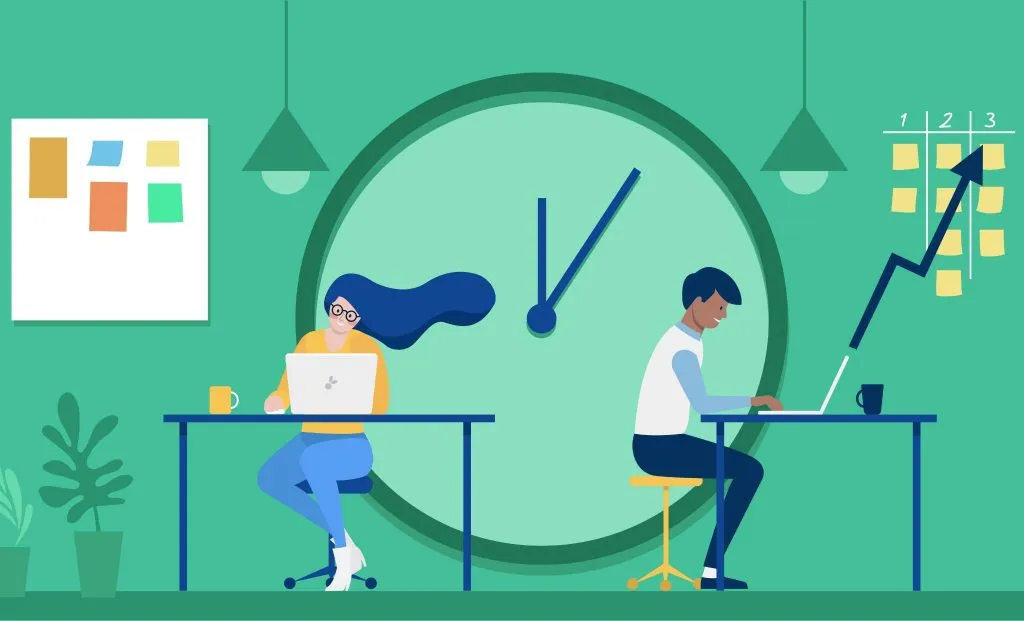
1. Set Realistic Goals
Goals should be attainable, measurable, and specific. They should also be time-bound because procrastination is one of our greatest productivity foes.
If you can’t finish a project in two weeks, it probably isn’t realistic enough—which doesn’t mean you shouldn’t start it!
Just remember that if you set your sights too high from day one, you won’t feel you can make progress and will get frustrated.
This is where breaking down large projects into smaller, more manageable tasks is helpful. Think about quarterly goals instead of figuring out what needs to be done in your business within a year.
Isolate objectives and goals by month or even week. It might seem like an easier way to approach things, but it’s also critical for keeping you accountable and motivated throughout your workday.
That way, if you miss a deadline or fail in some other way, you can catch up on time without too much stress.
2. Set Deadlines
Deadlines can help keep you focused and on task. Don’t just have a general idea of when you want to complete something, but set a firm deadline for yourself. That way, you’ll know exactly when you’re supposed to have your work done.
Deadlines are also a great motivator—every time you think about making an excuse not to work, remind yourself that there’s a definite date when all of your efforts will pay off.
Make sure deadlines are realistic enough not to cause anxiety or overwhelm but make them strict enough to motivate and consistent with what’s expected of professional workers.
Try the best employee monitoring software and always stay at the top of your deadlines.
3. Delegate Regularly
Delegating tasks means you can focus on those activities that are most valuable. As a bonus, delegating tasks makes it easy for employees to develop skills and increase their confidence in future projects.
If you have a big job or work on a large project, break it down into chunks and delegate specific jobs to each person or team. This helps ensure that all parts of your project move forward quickly and simultaneously—and doesn’t let one person do all of the heavy liftings.
Is delegating tasks a time-consuming activity for you?
Try the best employee scheduling software to automate your scheduling tasks for better efficiency and productivity.
4. Remove Distractions
A lot of people are constantly busy but unproductive. Instead of working on an important project, they work on tasks that don’t have an impact.
To be more efficient, you need to focus your attention and block out all potential distractions: emails, social media notifications, and meetings with co-workers who might pull you away from your current task.
To remove distractions quickly and easily, install software such as Boomerang for Gmail and Pocket for Chrome, which allows you to temporarily park incoming messages and articles to read them later—and then get back to what matters.
5. Prioritize Action over Perfection
Some people see perfectionism as a good thing, but it is often nothing more than an excuse for procrastination.
To maximize your productivity, prioritize action over perfection.
Perfectionists are less likely to get things done because they’re too concerned with details, aesthetics, and other minutiae rather than finishing projects quickly.
Don’t let a fear of imperfection prevent you from achieving your goals.
6. Set a timer
You can set a timer for every hour of work you do at work. When that buzzer goes off, stop what you’re doing and think about what you accomplished during that time. A break can allow you to reflect on your day’s tasks and get ideas for what to do next.
If you don’t see much productivity in your first go-round, take a few minutes to rest and then set another timer for another hour of work. Setting timers may seem like an odd way to stay efficient.
Still, it encourages you to stop working periodically throughout your day—which will make you more productive over time—it can be a helpful technique.
7. Stop Multitasking
Multitasking sounds like a good idea, but studies show it’s not only inefficient it can also damage your brain.
Research shows that when you try to do multiple things simultaneously, you get less done with each thing than if you’d done them one by one.
People who multitask in general are more likely to make mistakes and have attention problems later on down the road.
It is far better to focus intently on one task or project for an extended period of time—and then take a break. You will become much more efficient than before.
8. Brainstorm Before Hand
Many people don’t like brainstorming sessions because they seem complicated and unproductive.
But for those who are stuck, a brainstorming session is a great way to get unstuck.
You don’t need to use any special software or access anything on Google; some of our most productive sessions have happened in person.
All you need to do is take ten minutes to write all your ideas and questions—and stick with it until you feel you have more than enough to work with. Try taking short breaks every five minutes or so when your mind wanders too much.
The Smarter Approach to Productivity Management- Workstatus
Performance vs Productivity: Workstatus is a productivity management software that offers a smarter approach to tracking employee productivity and managing projects. It also offers employee productivity analytics, which can help managers make data-driven decisions to improve team performance.
Here are its key features:
-
Time Tracking
This feature allows employees to track their time spent on various tasks and projects, providing managers with insights into how time is being allocated across the organization.
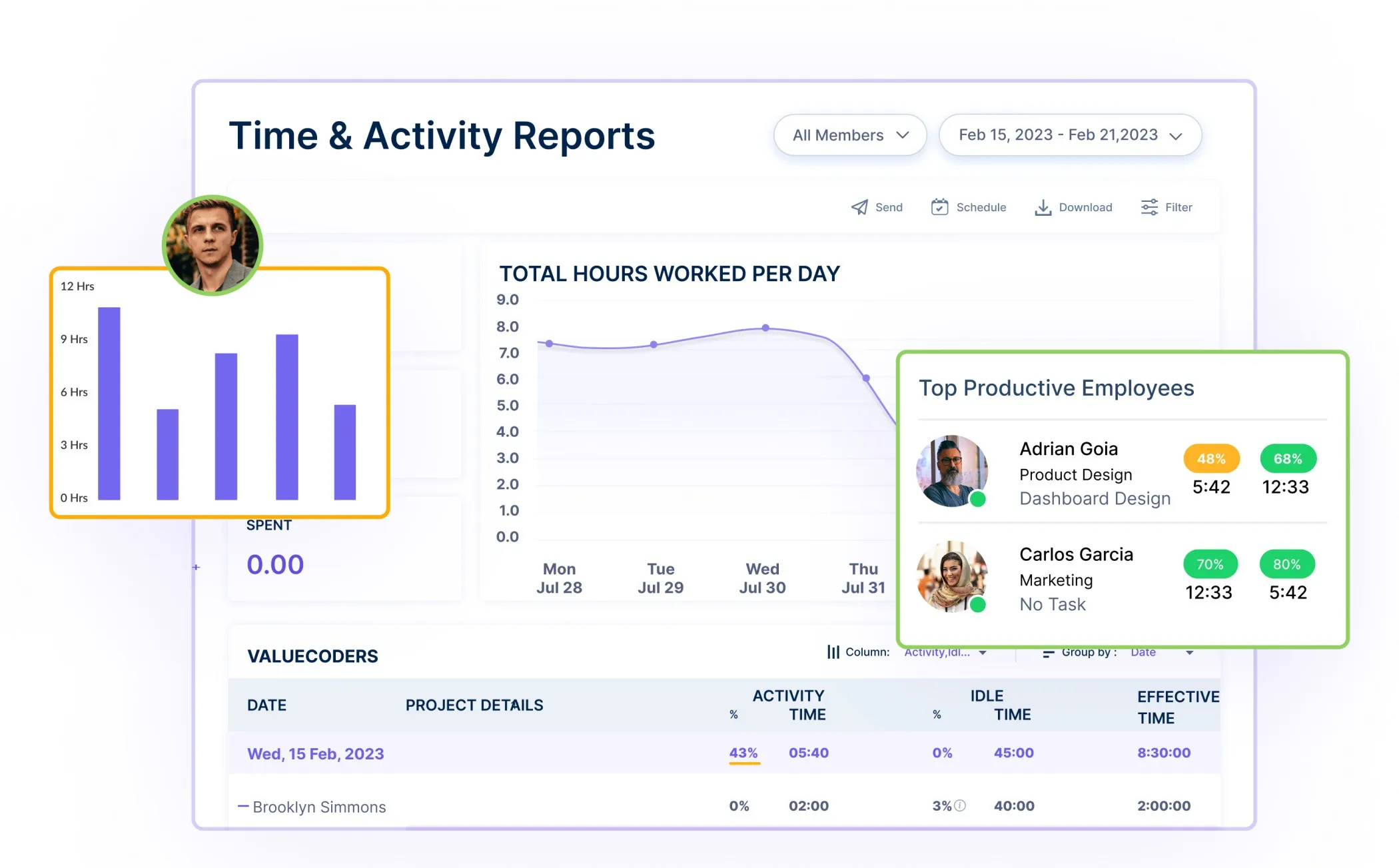
It can help identify areas for improvement and ensure that projects are being completed on time.
-
Productivity Meter
The productivity meter feature tracks the productivity of employees based on their completed tasks and output. ![]()
It can help managers identify top performers and areas for improvement, as well as provide motivation for employees to increase their productivity.
-
Reports & Analytics:
Reports and analytics features provide managers with valuable insights into team and individual productivity, including data on completed tasks, time spent on tasks, and overall project progress.
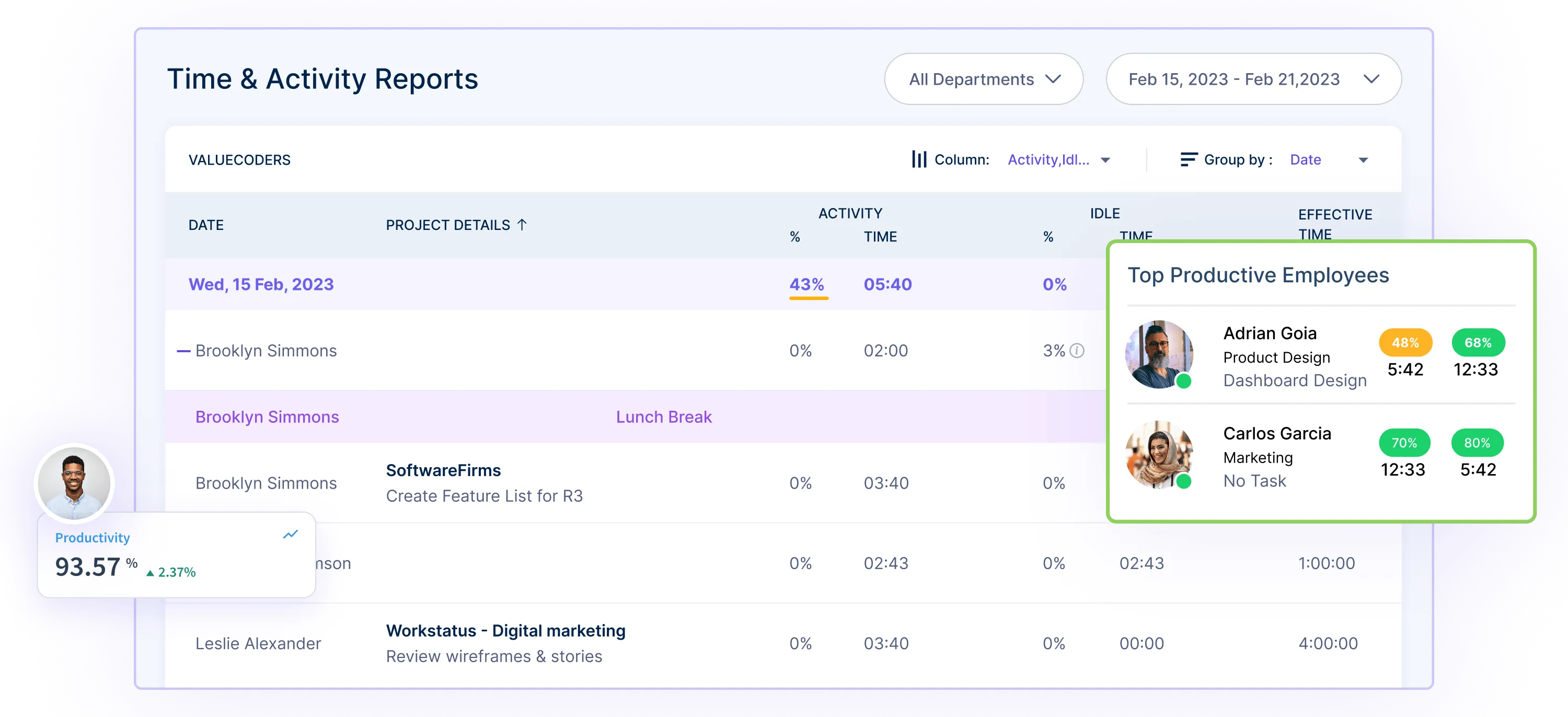
It can help identify potential issues or areas for improvement and can inform data-driven decision-making.
-
Project Progress Tracking
Project progress tracking features provide managers with real-time insights into how projects are progressing, including information on milestones, deadlines, and team member contributions.
![]()
It can help ensure that projects are on track and can help identify potential issues or areas for improvement.
Workstatus is a flexible solution that integrates with popular tools such as Trello, Asana, and Jira, making it easy for organizations to implement and use.
Closing Thoughts
This blog’s purpose was to familiarize you with the difference between productivity and efficiency and provide some tips on how to be more productive. We hope you found it helpful!
Consider using productivity tracking software, if you need a comprehensive solution that can help with time management, goal setting, task delegation, and more. This type of software can be an invaluable tool as you work to increase your overall efficiency and productivity.
Sign up to try the best productivity tracking software to monitor employee productivity and become more productive and efficient than ever
Have you implemented any of the techniques mentioned in this post? What worked best for you?
Let us know in the comments below-




